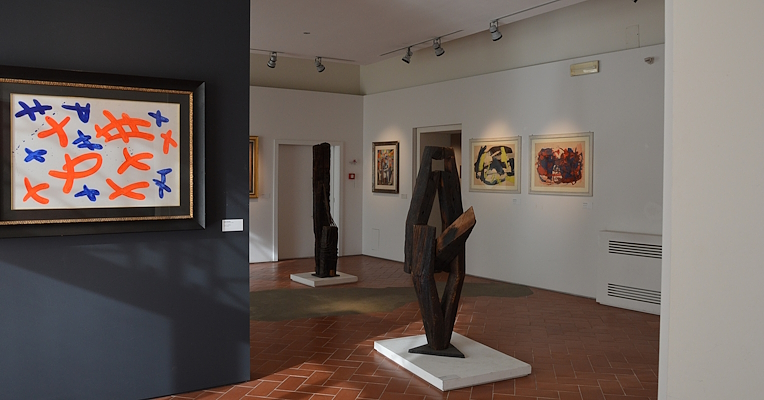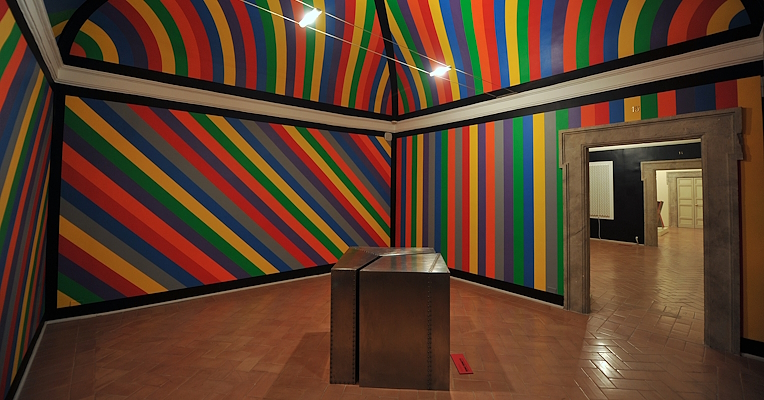For those who love art and contemporary art, Umbria can be a real surprise. This itinerary takes you through three cities that are home to must-see attractions: permanent exhibitions as well as outdoor artworks by artists who have shaped modern international art in recent decades.
Palazzo Collicola and CAOS: contemporary art in Umbria - Palazzo Collicola and CAOS: contemporary art in Umbria
A contemporary art itinerary in Umbria, from Todi to Spoleto

Todi, the beautiful Umbrian town rich in history and art, considered by recent studies to be “the most livable city in the world”, has always shown great sensitivity and openness to contemporary art.
Here, you can admire the Beverly Pepper Park, entirely designed by the famous American artist. The magnificent garden, adorned with sculptures, spans about two hectares and connects the most significant monumental landmarks of the Umbrian town. It stretches from the medieval Church of San Fortunato to the Renaissance Temple of Santa Maria della Consolazione, passing through the Rocca (fortress). The park houses around twenty sculptures by the artist, made from various materials and belonging to different periods—ranging from 1960 to 2000—including a re-edition of the famous Todi Columns, four monumental sculptures created for an exhibition at Piazza del Popolo in 1979, later displayed in many locations and eventually in Venice, in the courtyard of the Thetis space at the Arsenale.
Additionally, at No. 25 Via delle Mura Antiche, amid the splendid maze of alleys, small squares, and glimpses offered by the Umbrian town, you can admire a house that is both an artist's residence and a work of art: Casa Dipinta (the Painted House). The New York-based Irish art critic and artist Brian O'Doherty, along with his wife, art historian Barbara Novak, purchased this 19th-century house in 1975 to spend summers there, deeply in love with the Umbrian land. Over the course of more than 40 years, Brian, with the help of his wife, painted all the walls with frescoes of his works and reproductions of an ancient Irish alphabet. The house, which spans three floors, has become an incredible immersive work of art summarizing O'Doherty's artistic career, with his pieces displayed in museums worldwide. It is a triumph of color and love—between Brian and Barbara and between them and the Umbrian town that welcomed them. Sadly, Brian O'Doherty passed away in 2022; while visits used to depend on the couple's availability when they were in town, today Casa Dipinta is a true museum, though with limited opening hours. One, Here, Now—these three words written at the entrance encapsulate the language of the Irish artist and make the visitor an integral part of the work.

Head to Terni, where medieval Umbria gives way to modernity. Maraniello, Mastroianni, Ceccobelli, and Pomodoro have left their mark on the city, blending sacred and civil art. Arnaldo Pomodoro, in particular, is the artist behind Terni's symbol: Lancia di Luce (Spear of Light), created between 1984 and 1991. This 30-meter obelisk, made of various stainless steel alloys (a unique example in Pomodoro’s art, as he typically uses bronze), is the largest work of art in the world made from this material. It represents the memory of the past, linked to the steelwork that deeply shaped the identity of the Umbrian town, while also symbolizing its projection toward the future and new achievements. You can admire this exceptional work in the center of the roundabout bearing the same name, serving as a sort of gateway to Terni's historic center via one of its main streets, Corso del Popolo, which features other notable presences: those of artists Mario Ridolfi and Wolfgang Frankl. Your next destination is CAOS, Centro Arti Opificio Siri, a former papal ironworks, then a factory, and later a chemical research company. This site has played a significant role in Terni's history and remains the city's epicenter. From production to culture: today, it houses the collections of the Archaeological Museum and the Aurelio De Felice Museum of Modern and Contemporary Art. It also hosts an experimental theater, a café where you can take a relaxing break, a bookshop, and various educational workshops.
The idea was to create a total synergy between all the arts: a place where you can engage with the concept of contemporary art in all its forms. The space, arranged with innovative criteria, hosts works spanning from the 15th century to today. Among the featured artists are Aurelio De Felice, Severini, Chagall, Mirò, Picasso, and Kandinsky: an excellent example of the repurposing of a disused industrial area.

Welcome to the city of the Festival dei Due Mondi (Festival of the two worlds)! If you have the time and inclination, this city—once the Roman Spoletium, a Lombard duchy, and later an important Renaissance center—abounds with buildings and monuments connected to both its ancient and recent past.
The town boasts an exceptional collection of contemporary art housed at Palazzo Collicola Arti Visive (Collicola Palace Visual Arts). The initial nucleus of the collection was formed with the works of the Premio Spoleto (1953-1968), conceived with the aim of establishing a permanent public collection of contemporary art in Spoleto. The project originated from an idea by Mayor Toscano, artist Leoncillo, and some young artists who would later become known as The Six of Spoleto (De Gregorio, Marignoli, Orsini, Rambaldi, Raspi, Toscano), who had been exhibiting together at the Spoleto gallery "Il Ponte" since 1951. The Six of Spoleto, known for their openness to the main movements in Italian art at the time, fully embraced the broader movement of renewing European art (they were in fact associated with "Umbrian Naturalism"). The other major part of the collection dates back to the summer of 1962, when, during the fifth edition of the Festival dei Due Mondi, the exhibition "Sculpture in the City" was inaugurated. The streets and squares of the historic center were filled with 104 sculptures—some of which were later permanently donated—created by 54 of the greatest sculptors of the 20th century. This is why you can still admire works like Alexander Calder's Teodelapio, in front of the train station, or Arnaldo Pomodoro's Colonna del Viaggiatore (Traveler’s Column) between Via Flaminia and Viale Trento e Trieste. The 1962 exhibition was one of the most important events in the history of 20th-century sculpture.
To visit Palazzo Collicola Arti Visive, you must head to the city center. The museum consists of three main sections. On the ground floor, an entire room is painted by the artist Sol LeWitt, one of the leading figures of American minimalism, who created here one of his wall drawings, titled Band of Colors. This area also hosts the large spaces reserved for important temporary exhibitions frequently held in the palace. On the first floor, you can admire the opulence of the 18th-century noble family Collicola: it was Cardinal Francesco who commissioned the construction of this splendid palace, designed by the Roman architect Sebastiano Cipriani. The palace retains much of its original furnishings, ceilings, and doors; some rooms house a gallery with paintings from the 16th to the 19th century, including the famous Spezieria attributed to the school of Guercino.
The second floor houses the “Giovanni Carandente” Gallery of Modern Art, featuring works by internationally renowned artists such as Arnaldo Pomodoro, Henry Moore, Ettore Colla, Beverly Pepper, Lynn Chadwick, Afro Basaldella, David Smith, Alexander Calder, Henry Moore, Nino Franchina, and Pietro Consagra, Leonardo Leoncillo. The current, recently updated museum layout is organized into thematic rooms (Spoleto 62, Premio Spoleto, The Six, School of San Lorenzo), monographic sections (Pepper, Calder, Leoncillo), or stylistic ones (Italian Abstraction, Beyond Abstraction, Figures and Returns); the collections are subject to periodic rotations, which highlight the works by placing them in different contexts each time. Palazzo Collicola is therefore a living museum, which, thanks to new acquisitions, grows, changes, and continuously evolves, representing one of the most significant experiences in contemporary art in Italy.
Finally, Palazzo Collicola also houses the Caradente Library, where you can find more than 30,000 volumes, mostly related to modern and contemporary art, as well as art magazines and archival collections from art critic Giovanni Carandente, important Spoleto artist Leoncillo Leonardi, and the Premio Spoleto.SEO Keywords:
























